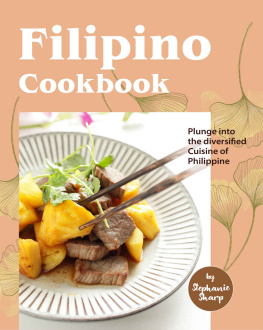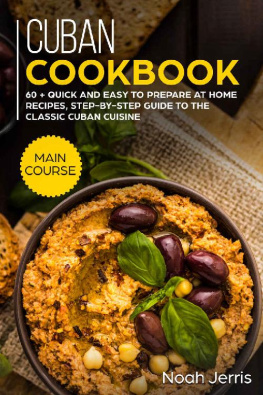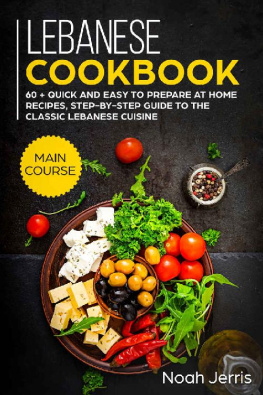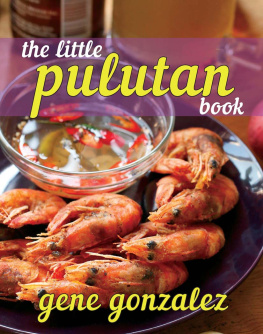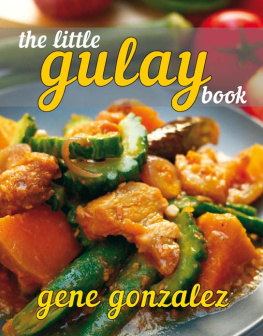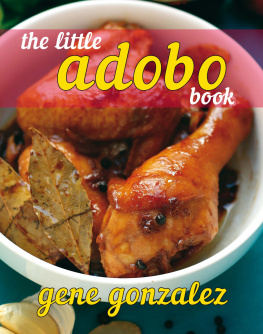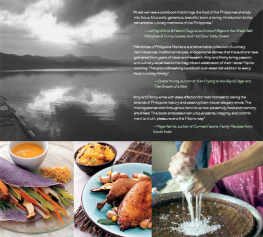The Little Kakanin Book
Gene Gonzalez
Copyright GENE GONZALEZ, 2015
All rights reserved. No part of this book may be reproduced in any form or
by any means without the written permission of the copyright owner and
the publisher.
Published and exclusively distributed by
ANVIL PUBLISHING INC.
7th Floor Quad Alpha Centrum Building
125 Pioneer Street
Mandaluyong City 1550 Philippines
Telephones: (632) 477-4752, 477-4755 to 57
Locals 815 and 817
Fax: (632) 747-1622
www.anvilpublishing.com
Book design by ANI V. HABLAN (cover) and JOSHENE BERSALES (interior)
Food styling by NOVIA DAVID ZAPATA
Front cover photo by CROWN DOLOT
Photo of the author on the back cover by WENDY BASILIO
Illustrations by ANI V. HABLAN
ISBN 978-971-27-3192-1 (e-book)
Kakanin
K akanin as a type of food stems from multi-dimensional meaningsfrom the root word kanin (rice) as a noun or kanin (to eat) as a verb. With the prefix of ka, kakanin describes many kinds of rice recipes meant to be eaten as snacks of the many ways of cooking snacks or desserts to celebrate the harvest of the Philippine Islands. Ancient customs and practices also use kakanin as offerings to the gods. Every island, province or town may have their own recipe for kakanin depending on their geographical location and the areas basic staple food like purple yam and taro. Kakanin as a word may also mean a small serving of food, something to tide one over before a main meal or simply some colorful snacks or desserts to look forward to during fiestas. Food to the Filipino, as in other cultures, is a precious source of strength and spirit and could be a vehicle of harmony among friends, relatives, and even strangers.
Introduction
W hen you talk about kakanin, it is almost always associated with laborious procedures and preparations. More often than not, it is also associated with the traditional and old fashioned. At a time when other countries have been digging deep into their treasures and classic recipes to preserve their heritage, I tried to look for simple and simplified versions of Filipino kakanin. I hope that this collection of recipes would dispel the common belief that our popular snack is difficult to make and can only be eaten during special occasions. I wish to thank Mr. Ed Gabito for all those sessions, discussions and recipe exchanges during the writing of this little cook book. My thanks, too, to Marilyn Espino who broached the idea of the Kakanin cook book and to Kuya Boy Padilla of Lasap Pagkaing Pilipino and Alfred Padlan of Bibingka Republic for helping me kitchen test the recipes.
Contents
milled rice and water
| Galapong bigas is one of the more essential ingredients in rice cake or kakanin-making. Most Philippine markets sell galapong from regular rice (bigas) and sticky or glutinous rice (malagkit), which is soaked the night before and then ground. Trapped wild yeast often causes this mixture to ferment, thus aiding the rising in rice cakes. | This is not ideal for other types of kakanin like sapin-sapin, or kalamay and galapong. For these types of kakanin, the galapong bigas has to be freshly ground. Most old or traditional homes have their stone grinder made from granite. These grinders can still be purchased in provincial markets. |
Galapong bigas
food processor or blender method
- Soak rice in water overnight or for a minimum of 4 hours, using 2 cups water for every cup of rice.
- Mill in food processor starting with a small quantity, adding soaked rice little by little until it produces the consistency of light dough.
| 
The Chef Says:
Fill only up to 1/3 of the blender so the machine wont overheat. |
|
Buko
Young coconut with soft meat, used for mixing with fresh kakanin or other pastries. Maturity is based on meats thickness. Malauhog translucent and gelatinous Alanganin between white and gelatinous; tender Malacanin like white rice, mealy
Niyog
Mature coconut normally used for grating and extracting coco cream | Kakang gata
(Coconut cream) first extraction of coconut cream from freshly grated mature coconut. Normally about 1/2 cup of water is added to one whole grated coconut as catalyst. Kakang gata is extracted by slowly squeezing the grated coconut placed in a piece of cloth
Gata
(Coconut milk) second or third extraction by adding about 1 cup of water as catalyst putting it in a piece of cloth and squeezing the ends to extract the milk |
Desiccated coconut
Dried coconut shreds used often in toasted form
Macapuno
Genetically recessive coconut with oily and gelatinous coconut; translucent and thick meat. Used as topping or filling in sweetened form | Latik
Coconut milk that is heated and simmered until the curds separate from the oil. This is further simmered or fried in its own oil depending on how toasted one likes their latik
Powdered coconut cream
When hydrated or mixed with water, it can be used as a substitute for fresh coconut milk. Though it is an acceptable substitute, it cannot be used for the making of latik |
|
 |
Kamoteng kahoy
(Cassava) used widely in different forms from whole, grated, mashed or in flour form
Ube
(Purple yam) uses are the same as cassava but is widely favored because of its purple color | Gabi
(Taro) used in mashed form as main base for kalamay and other cooked forms such as ginataan |
|
 |
Mais
Used fresh or dried. Native white variety is more glutinous than the sweeter yellow variety. | Rice
Malagkitglutinous rice used in all forms from whole grain to flour. Good binding qualities with lots of elasticity Bigasregular table rice used in risen cakes or kakanin like puto, certain forms of bibingka, etc. Pinipiggreen unripe rice, harvested and husked. Chewy and glutinous and has light flavors reminiscent of straw and hay. Has higher sugar content because the sugar has not been fully converted to starches in an unripe grain state. |
 |
Panutsa
Raw sugar shaped into round discs made by boiling sugarcane juice
Anis
Aniseed used for flavoring rice cakes such as puto and other types of kakanin
Lihia
Food grade lye mixed into steamed kakanin recipes in order to give a sheen to the outer surface |


